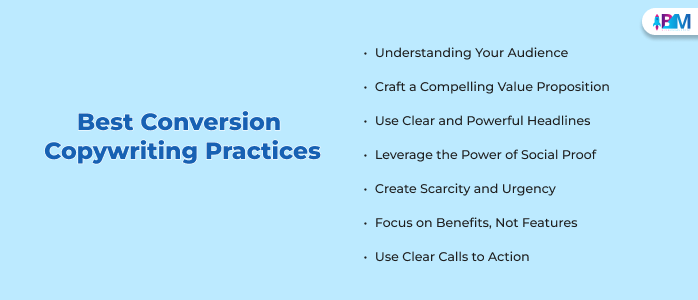Copywriting is the art of raising awareness and selling products using the right words in the best order. The term “copywriting” was greatly associated with writing advertisements for magazines, television, and outbound media.
However, with the changes in the present dynamic society, the tasks of a copywriter have been changing. Traditional copies have been shifted towards making digital web copies, blog posts, Google ads, social media posts, and more.
Conversely, conversion copywriting is the linking thread between the above content marketing modes. Conversion copywriting aims to move the reader to say “yes” to your service offerings. This level of persuasion is done through copywriting. Here, we will analyze conversion copywriting and how to write compelling copy.
What Is Conversion Copywriting?

In layman’s terms, conversion copywriting is making copies with the end goal of converting readers into buyers. Hence, conversion copywriting uses persuasive language and engaging content to motivate readers to take any specific action.
These actions could include agreeing to buy the service, applying for newsletters, or taking other similar actions. While the end goal of conversion copywriting is to motivate readers to make a purchase, businesses can use it at every stage of a buyer’s decision-making.
Hence, you can use conversion copywriting to inform your prospects about their pain points, motivate them to sign up for emails and newsletters, or boost brand awareness.
Moreover, conversion copywriting falls under website conversion optimization, which allows you to use your website to convert prospects across your blog, pricing page, homepage, and more.
Example Of A Perfect Conversion Copy
Check out this example of Slack’s website:
Slack is a popular team collaboration tool that shows exceptional conversion copywriting efforts on its website’s homepage.
The headline instantly attracts the audience’s attention: “Slack is where work happens.” This crisp, direct statement effectively captures Slack’s primary essence regarding the services offered without any bluff.
The sub-copy highlights how Slack can effectively improve employee productivity by focusing on features such as file sharing, real-time messaging, and incorporation of other key tools.
The direct articulation of such advantages directly addresses the pain points in office communication.
Moreover, the call to action (CTA) “Get Started for Free” is highly visible and strategically placed. These words are simple yet action-oriented, and the word “free” is a great incentive to attract the prospect’s attention.
Slack further adds an additional CTA that notes, “See Slack in action.” This demo gives an additional push for prospects who are difficult to impress. By maintaining clarity, focusing on key benefits, and including effective CTA, Slack does a fantastic job of guiding readers to sign up.
This is a great example of how effective conversion copywriting is and how it can used to direct users to make the desired action.
Best Conversion Copywriting Practices

Here are some of the best conversion copywriting practices:
1. Understanding Your Audience
Understanding your audience is vital to writing compelling conversion copy. The best way to do this is by understanding their preferences, pain points, demographics, and motivations. You can gather information utilizing efficiency-boosting benefits. Knowing your audience gives you an automatic advantage in crafting the best copy.
Moreover, understanding your audience will allow you to personalize your business’ messages to fit their needs. Netflix is one such company that uses effective data analysis to recommend tailored content to its viewers, thereby boosting user engagement.
2. Craft A Compelling Value Proposition
Your value proposition should clearly define the benefits your service or product offers to their clients. Simply explaining what you do is not enough. You need to explain how your service or product benefits your target audience.
An effective value proposition addresses the key concerns and makes you stand out in a pool of competitors. For instance, instead of saying, “We offer fast delivery,” say, “Receive your order within 24 hours, or it is free!” This strategy adds an extra layer of assurance and urgency.
3. Use Clear And Powerful Headlines
The very first thing your audience sees is the headline. Hence, it is imperative to make your headline informative and intriguing, capturing the audience’s eyes almost instantly. Moreover, a headline piques a reader’s interest, based on which they decide to read the content.
For example, “Change Your Skin in 20 days (about 3 weeks) with Our Revolutionary Beauty Cream” is much more engaging than simply using “Buy Our Beauty Cream.”
Hence, the former promises benefits and sets expectations. Moreover, companies like BuzzFeed have excelled in creating fascinating and engaging content with high click-through rates.
4. Leverage The Power Of Social Proof
Social proof is a powerful tool for increasing trust and establishing credibility. Examples of social proof include case studies, reviews, and testimonials. Providing statistical data and client feedback can persuade new customers to visit your page and act.
Amazon is the best example of a business that has outstandingly used the benefits of social proof. They proactively display ratings and real user reviews, allowing potential customers to make informed decisions.
Another example of a B2B business is Dropbox, which uses client testimonials on its website’s homepage to highlight the key benefits of using its diverse services.
5. Create Scarcity And Urgency
Businesses should create a sense of urgency in their copy to urge customers to act quickly. For example, they could add phrases like “Sale Ends Tomorrow” or a countdown timer on the homepage to prompt customers to take immediate action.
You can also use words like “Limited Time Offer” or “Only a Few Stocks Left.”
Booking.com, for instance, uses this urgency strategy in its service listing, showing the number of remaining rooms and the number of users viewing the same hotel in real-time.
This strategy motivates users to make quick decisions and reduces the possibility of procrastination.
6. Focus On Benefits, Not Features
While it is crucial to mention your product’s key features, you must emphasize the advantages of using those features. Your customers want to know how your product or service would benefit them.
For instance, instead of simply saying, “Our smartphone has 32GB RAM,” say, “Experience smooth multitasking and lightning-fast performance with our latest smartphone.”
A good example of a company that uses this strategy fantastically is Tesla. Instead of highlighting the specific technical features of the electric vehicle, Tesla focuses on highlighting its benefits, such as safety, sustainability, and long-range.
7. Use Clear Calls To Action
Crafting a compelling call to action directs your audience to take the next action. You must make your CTA stand out and be ultra-specific about what action you want your customers to take.
For instance, avoid generic CTAs like “Click Here,” you can use alternatives like “Start Your Free Trial” or “Get Started with Free Tools.”
Conclusion
Conversion copywriting is a great technique for increasing user engagement and attaining corporate objectives.
Understanding your audience, building appealing value propositions, utilizing effective headlines, leveraging social proof, creating urgency, emphasizing benefits, and offering clear CTAs will all help you greatly increase your conversion rates.
These methods, demonstrated by successful organizations such as Netflix, Amazon, Tesla, and HubSpot, demonstrate that good copywriting is more than just selling items; it is also about making a genuine connection with your audience and persuading them to act.
Read Also:
